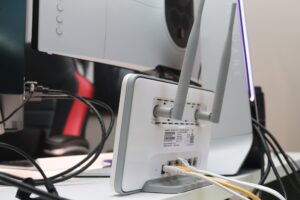
Next-Generation WiFi Analytics Automate Network Monitoring

WiFi network monitoring is the regular, systematic review of a WiFi network. With monitoring, an eye is kept on the operations, but it can be very time consuming and reactive. Network analytics are an automated deep-dive. They deliver the understanding of why something is happening, not just what has happened, as well as how to fix it and prevent it from occurring again.
What are next-generation WiFi analytics and how can they help?
Next-generation WiFi refers to technologies like WiFi 6, WiFi 6e devices, virtual reality, many IoT devices, and AI solutions. These next-generation WiFi devices are used to provide more and more value for enterprises and users, and are necessary to the realization of critical business goals. Next-generation WiFi analytics solutions are needed to keep these technologies optimized.
These solutions help by automatically analyzing WiFi network performance. They can analyze tens of thousands of data packets a second, which allows them to keep tabs on every device connected to the network as well as the network itself. They provide real-time WiFi analytics – which means they deliver insight into exactly why something is happening on a network at any given time. With this level of visibility and detail, enterprises ensure that the network that all next-generation devices depend on is consistently reliable and high-performing.
The benefits of implementing next-generation WiFi analytics
We mentioned it above, but visibility is a key benefit of implementing a next-generation WiFi analytics solution. Another benefit is actionable information. These solutions work for IT teams, supplying them with the insights they need to do their jobs, rather than simply providing more data that teams must sift through and analyze on their own time.
These benefits result in:
- Improved network performance: More visibility, delivered in real-time, allows IT to be alerted to network issues as soon as they occur. Problems can then be resolved faster, improving network performance.
- Enhanced network efficiency: A network with fewer problems is one that works more efficiently.
- Better user experience: A reliable, optimized network is always better for users. This is especially true if the network is optimized for a user’s specific needs. With richer insights, IT teams know more about network utilization and can recommend upgrades and updates that will improve the network so that it meets and surpasses user expectations.
7 key features needed in any next-generation WiFi analytics solution
If you want to adopt a solution to improve your network’s performance, look for these features:
- AI-driven WiFi Analytics: A solution must be AI-driven to provide the proactive and automated features that will deliver real-time insights. With an AI-engine, solutions can learn to recognize normal and abnormal network behavior. With this understanding, the solution can communicate any changes to network performance, delivering the “why” and not just the “what.”
- Real-time data insights: The solution should save IT time and that means IT should know what is happening on the network in real-time. Data insights, including problem identification and actionable resolutions, should be delivered promptly and automatically so that IT can respond proactively and not reactively.
- Comprehensive network visibility: True optimization and WiFi assurance are only possible if the entire network ecosystem is visible and under analysis. This includes connected devices, backend and frontend infrastructure, and any possible source of interference, whether it comes from a WiFi or non-WiFi source.
- Automated user experience optimization: The solution should automatically deliver insights that will optimize the user experience. IT should not have to manually run testing. To reflect the user experience, the solution must be able to connect to the network as a user device when running tests and analyzing network performance. Look for a solution that was designed to have UX optimization as a main feature. A way to determine if a certain solution delivers is to find out by how much it reduces problem resolution times and whether or not it significantly reduces the overall number of network problems.
- Historical wireless traces: Historical wireless traces allow IT professionals to see exactly what was happening on the network at any given time. A solution should automatically save wireless traces so that IT can have as much visibility as possible into network behavior.
- Remote capable: IT must be able to troubleshoot network problems from anytime and any location. A remote-capable solution is necessary for any enterprise that wants to reduce the time and money spent sending IT to different locations.
- Vendor agnostic: The solution should be capable of analyzing all networks and infrastructure, and should be easy to install and use at any enterprise location. It should not be vendor-specific or vendor-focused.
Lock-in maximum network performance and efficiency with next-generation WiFi analytics
As WiFi networks, and their connected devices, become more crucial to operational efficiency and enterprise success, they also become more complex and congested. Next-generation WiFi analytic solutions are the key to long-lasting optimization that is budget-friendly and easy-to-obtain.
The AI-driven Wireless Intelligence Platform™ (WIP) delivers:
- 90% faster Mean-Time-to-Resolution
- 70% fewer WiFi problem tickets
- 80% fewer remote site visits
Talk to us today about a demo or trial, and see how organizations use WIP to experience worry-free WiFi.


